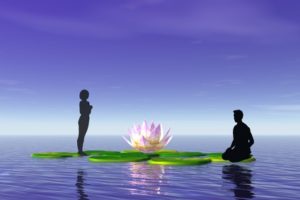“When the breath wanders, the mind also is unsteady. But when the breath is calmed, the mind too will be still.” (Hatha Yoga Pradikipa)
Why is there such an emphasis on the importance of breath and particularly on ‘moving with the breath’ in yoga practice? The breath is our life energy (prana) and the in- and out-breath is what nourishes and cleanses our body and mind. The quality of the breath tells us something about our physical and emotional state – whether we are relaxed, tense, stressed or balanced.
In yoga practice, the breath is critically important from a physiological, mental and emotional perspective. Whether one or the other connects more with you initially does not matter, as long as the breath plays a central part in your practice. With time, all the other aspects will fall into place.
The physiological and anatomical significance is associated with the muscle that moves the lungs, the diaphragm. The diaphragm is the primary breathing muscle. By understanding how it connects to other anatomical structures, we get a better appreciation how conscious breathing affects further parts of the body:
The diaphragm attaches to the bottom 6 ribs and joins on to 2 or 3 lumbar vertebrae. These two attachments (ribs and lumbar vertebrae) are shared with the transverse abdominus (the deepest of our abdominal muscles) and the psoas (one of our most important hip flexors and the one that gets short and tight from prolonged sitting). That means that with each full inhale and exhale there is a follow-on muscular action to the abdominal muscles and the muscles of the spine and pelvis.
Particularly in vinyasa-style asana practice, it helps to engage in a particular style of breathing: the Ujjayi (victorious) breath.
Becoming skilled at Ujjayi breathing so that it develops into a natural part of your practice may take a while. The easiest way to learn Ujjayi breathing is simply by sitting or standing and focusing first on your out-breath: restrict the back of your throat slightly, so that the breath originates deeper in your throat (between your collarbones). Notice how this restriction will cause a slight sound: the breathing shifts from being nasal to more throaty and is associated with a sound like being under water or the sound of the sea in a shell. Then follow on in the same manner with your in-breath, aiming to keep the in- and out-breath at approximately the same length. Ujjayi breathing produces internal heat and in addition to the external heat produced by muscular action, it helps to make our practice smooth, subtle and enjoyable.
The mental perspective of yogic breath is associated with concentration, focus and mindfulness; as such, it is a meditative aspect. By keeping our mind focused on the breath (as well as on the visual focus point: the drishti) we are retaining an inward-drawn attention, rather than letting our mind engage into outward directed thoughts (‘I really need a pedicure’, ‘Why is she able to touch her toes and I can’t?’, ‘I must remember to pick up the dry-cleaning after class.’). The breath – and particularly the sound associated with Ujjayi breath – draws us back to ourselves, and by being mindful of the quality of our breath and how it changes during asana, it is possible to modify practice to suit the practice to the breath rather than vice versa. Essentially, this means that if you find yourself straining in a posture to achieve an illusory goal (like bringing your heels to the floor in downward dog or touching your toes in forward bend) and the breath becomes laboured, short, shallow or tense, you know that what you are doing is not yoga but feeding the ego and allowing yourself to slip into self-deception. Yoga is about truth, and the breath is one of the best instruments to gauge whether we are adhering to our own truth or whether we are being untruthful to ourselves or even self-harming.
The emotional side of breath is linked to our nervous system and hormonal glands: The ‘in-breath’ activates the sympathetic nervous system. This is the nervous system associated with the fight-or-flight response and stimulates the production and release of ‘stress’ hormones as well as the de-activation of internal organs and activation of peripheral muscles. The ‘out-breath’ is linked to the parasympathetic nervous system, which is associated with relaxation and recuperation. The parasympathetic nervous system inhibits the release of stress hormones and stimulates the nerves that run towards our internal organs (primarily the vagus nerve). Through the release of neurotransmitters (e.g. GABA: gamma aminobutyric acid) the heart rate slows and blood pressure decreases. During yoga practice, we aim for an even in- and out-breath to create harmony between activating and calming energy. However, for therapeutic purposes the length of the in-and outbreath may be varied (e.g. to nurture a calmer mind and body, a slightly longer out-breath may be practiced).
In summary, the breath is the critical link in our yoga practice – be it asana, meditation or pranayama. If we ignore the quality of the breath, we are violating the basis of yoga. To achieve physical and emotional well-being, we must understand that the breath descends physiological boundaries and can connect us with the essence of ourselves.


